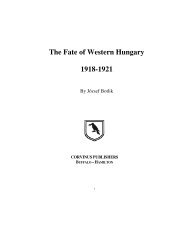Hungary and the Hungarians - Corvinus Library - Hungarian History
Hungary and the Hungarians - Corvinus Library - Hungarian History
Hungary and the Hungarians - Corvinus Library - Hungarian History
You also want an ePaper? Increase the reach of your titles
YUMPU automatically turns print PDFs into web optimized ePapers that Google loves.
ment bonds on <strong>the</strong> international markets. Between 1868 <strong>and</strong> 1890, state expenditures<br />
rose: in Austria by 72%, in <strong>Hungary</strong> by 142%; <strong>the</strong> country’s debt servicing cost reached<br />
30.1% of revenues in 1868 to 1870 <strong>and</strong> 34.7% in fiscal 1886 to 1890. A balancing of <strong>the</strong><br />
budget was finally achieved in <strong>the</strong> early 1890s.<br />
According to <strong>the</strong> estimate of katus, <strong>the</strong> economy grew on an average of 2.5% to 3%<br />
annually between <strong>the</strong> Compromise <strong>and</strong> <strong>the</strong> turn of <strong>the</strong> century, translating to an almost<br />
25% increase in per capita growth. In <strong>the</strong> second half of <strong>the</strong> 19 th c., backward countries<br />
were able to augment relatively quickly <strong>the</strong> missing, or in short supply means of production.<br />
The leading capitalist countries had foreign investments, in 1870, <strong>the</strong> equivalent of<br />
15 billion Forints, which rose to 40 billion Forints by 1890. A significant amount was<br />
invested in <strong>Hungary</strong>. About half of capital expenditures between 1867 <strong>and</strong> 1890 were<br />
thusly financed, from French, German <strong>and</strong> Austrian sources. However, <strong>the</strong> major sources<br />
of internal capital accumulation in <strong>the</strong> two decades following <strong>the</strong> Compromise remained<br />
agriculture <strong>and</strong> trade. (katus, 1970)<br />
The development of capitalist world economy entered a new phase in <strong>the</strong> years following<br />
1890. The building of an extensive railway system in Austria-<strong>Hungary</strong>, similar in characteristics<br />
to western European models, would not have been possible without foreign investment.<br />
Traditional internal sources of capital were insufficient to satisfy dem<strong>and</strong>. <strong>Hungary</strong>,<br />
as part of <strong>the</strong> Habsburg Empire, later part of Austria-<strong>Hungary</strong>, was <strong>the</strong> target of a<br />
large volume of foreign investment since <strong>the</strong> beginning of <strong>the</strong> 19 th century. Between 1867<br />
<strong>and</strong> 1914, 6.8 billion Crowns of Austrian <strong>and</strong> foreign capital was invested in <strong>Hungary</strong>,<br />
amounting to 40% of capital investments (1990 to 1913, <strong>the</strong> amount of Austrian <strong>and</strong> foreign<br />
investment was 1.75 billion Crowns). during <strong>the</strong> period of <strong>the</strong> dualism, <strong>the</strong> proportion of<br />
Austrian <strong>and</strong> foreign capital to internal capital accumulation, between 1867 <strong>and</strong> 1873, was<br />
60:40; from 1873 to 1900, 45:55; from 1900 to 1913, 25:75. (Berend-Ránki, 1974)<br />
248<br />
2. Characteristics of industrialization, transportation<br />
<strong>and</strong> <strong>the</strong> capital credit system<br />
<strong>Hungary</strong> arrived at <strong>the</strong> threshold of modern industrialization at a relatively low level<br />
of economy development, behind those western <strong>and</strong> central European countries<br />
where <strong>the</strong> Industrial Revolution began at <strong>the</strong> end of <strong>the</strong> 18 th or <strong>the</strong> first half of <strong>the</strong> 19 th<br />
centuries. In <strong>the</strong> last three decades of <strong>the</strong> 19 th century, <strong>the</strong> development of a modern<br />
<strong>and</strong> competitive manufacturing infrastructure required: a relatively developed general<br />
economic environment; an extensive railway network; trade <strong>and</strong> credit channels;<br />
significant entrepreneurial, organizational <strong>and</strong> technical expertise <strong>and</strong> experience;<br />
a large labor pool; <strong>and</strong> last but not least, capital investment. The <strong>Hungarian</strong> version<br />
of industrialization – <strong>the</strong> late start <strong>and</strong> low starting point, its place in <strong>the</strong> international<br />
capital economy (this last one due, above all, to <strong>the</strong> labor specialization in <strong>the</strong>
















